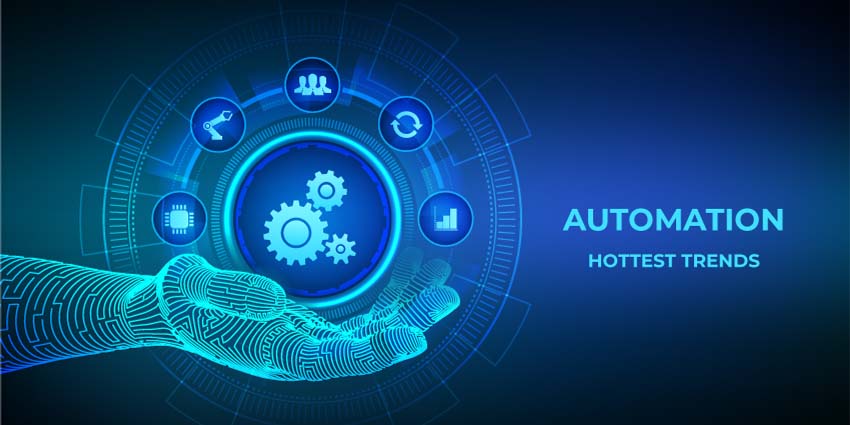Automation is everywhere in the modern business landscape. Enabling companies to accomplish more, with smaller investments of time and money, automation can give brands a significant edge in any marketplace. The technology is particularly valuable in the CX environment.
As customer expectations continue to rise, automation could be the key to ensuring companies can deliver service and support with the speed and efficiency their clients demand. Around 57% of business professionals in enterprises are planning on building automations specifically to improve customer experience in the next two years.
While it’s difficult to say for sure what automation might do for the CX landscape as we know it in the years ahead, there are some trends that seem to be influencing the industry.
1. Hybrid Work
Hybrid work and remote employees have prompted a significant increase in the number of companies investing in disruptive tools like automation, automated workflows, and AI applications. Automation isn’t just a way to make employees more productive when they’re trying to work from a range of different environments; it can also be an incredibly important tool for helping business leaders to manage hybrid teams.
With automated systems built into CCaaS technology and service desk tools, managers can automatically track things like agent productivity and engagement scores. HR professionals can keep a closer eye on things like shift changes and swaps between employees, ensuring the correct number of staff are available in a CX environment at any given moment.
Automated solutions can also provide extra support for employees in a hybrid environment who won’t always have access to things like IT teams to help with technology issues. An AI bot can automatically troubleshoot a problem and help keep staff members on track wherever they are.
2. Agent Experience
The focus on agent experience as a precursor to good customer experience in the digital landscape has significantly increased in recent years. Business leaders know they need to provide their employees with the right support and tools if they’re going to thrive in the modern landscape. This is particularly true now that agents are dealing with omnichannel interactions from various platforms.
With automation, companies can take some of the extra pressure off their employees, helping them to focus more of their time on the things they do best and less on repetitive tasks. Automated workflows can handle administrative tasks, data input, and similar jobs, while your employees focus on tasks requiring their unique levels of creativity and empathy.
Virtually all employees in the customer experience landscape can benefit from automation. Some studies show that around 20% of a CEO’s working time could be automated with the right technologies.
3. Increasing Digital Channels
One of the most significant challenges companies face as they struggle to stay ahead of the curve with customer experience lately is ensuring they can connect with customers on all the right channels. Consumers are now interacting with companies through a host of new platforms, from social media applications and WhatsApp to SMS, email, video, and audio. Employees need a little extra help from automation to keep on top of these conversations.
Automated technologies in the CCaaS environment can help to give employees more control over the conversations they’re managing each day without asking them to jump between apps to keep track of context. With an omnichannel environment featuring intelligent routing, companies can assign specific tasks to the employees with the right skills or the availability required to answer a question.
Automated systems can combine conversations from multiple channels into one inbox, so companies can more easily offer their clients more of the channels they want to use. Not only does this make your company more competitive, but the right systems can improve the speed with which you solve consumer problems too.
4. High Demand for Self Service
According to some reports, the pandemic (Covid-19) accelerated digital transformation by an average of 7 years. This means most of us live in a far more digitized environment today than we were only a couple of years ago. We’ve certainly seen evidence of this rapid digitization in the number of new channels consumers use to connect with companies.
Specifically, the majority of consumers now say they prefer to solve their problems themselves, with self-service solutions, or access digital tools when connecting with a brand. Automation tools in the CX environment allows companies to offer their customers one of their preferred methods of support in the modern world: self-service.
Automated bots and FAQ systems can give consumers quick answers to questions, so they don’t have to pick up the phone or wait for an agent to solve a problem. Increasingly, employees are becoming more reliant on self-service solutions too. Many staff members today use AI-enhanced automations to leverage information from knowledgebases and get answers to their own problems.
5. Increasingly Disruptive AI
Artificial Intelligence and automation form a natural partnership in the CX environment. The more intelligent your automated systems are, the more potential benefits they can offer when it comes to delivering excellent service and support customers.
AI in the contact centre can now align with automated workflows and tools to automatically collect information from critical conversations with customers. This information can help to provide reports and insights into trends in a marketplace. The same data can assist with everything from lead scoring to opportunity tracking, and more.
As we head into the future of CX, where AI and automation are more common, we’ll continue to see more advanced versions of AI workflows, built to help companies thrive. These tools could do everything from detecting sentiment in a customer’s voice, to automatically omitting any personal information from recordings to ensure a company remains compliant with regulatory guidelines.
6. Low Code and No Code
Finally, one of the most exciting new concepts to emerge in the automation environment in recent years, is the evolution of platforms and tools intended to give employees and staff members more control over their intelligent apps and automation.
In the past, companies relied on developer skills and experts with programming knowledge to make changes to automation workflows. With no-code and low-code platforms, future employees will be able to transition into “citizen developers”, making their own changes to their ecosystem in search for better productivity and efficiency.
No-code and low-code solutions are even beginning to appear in environments like the Microsoft ecosystem, where users can create automated workflows directly within Microsoft Teams – one of the top tools for collaboration in the current landscape.







